SmartDrive MX2 Review
The SmartDrive is a power-assist device that attaches to a manual wheelchair. It works by adding a fifth, powered wheel to the rear of the chair. The wheel attachment also houses the battery, so there is no need for a separate battery pack, as there was with the original SmartDrive. The SmartDrive's power is controlled by a Bluetooth wristband that looks similar to a FitBit, which has an on/off/mode button and a movement sensor that controls stop/go. Active wheelchair users may appreciate the added boost to their functional mobility in the community.
This video from Max Mobility shows the SmartDrive MX2 in action:
The info I'm providing here has come from a demo session with a supplier, the SmartDrive MX2 User Manual,
internet research, and stories from SBH Queensland therapists (Elizabeth Steele and Angela Tincknell)
who have used the product with some clients, with varying outcomes.
If you have more or different information, please share it by commenting below.
Some specifications:
- Fitting: The SmartDrive unit clips into a clamp. Two different size clamps are available for fixed frame chairs (standard size fits up to 1in (25mm) diameter camber tube, larger size also available). Two different size adaptors are available for folding frame chairs (widths: 11-15in (28-38cm) and 15-19in (38-48cm)). Only one clamp/bracket is supplied with the SmartDrive, so a choice must be made prior to ordering.
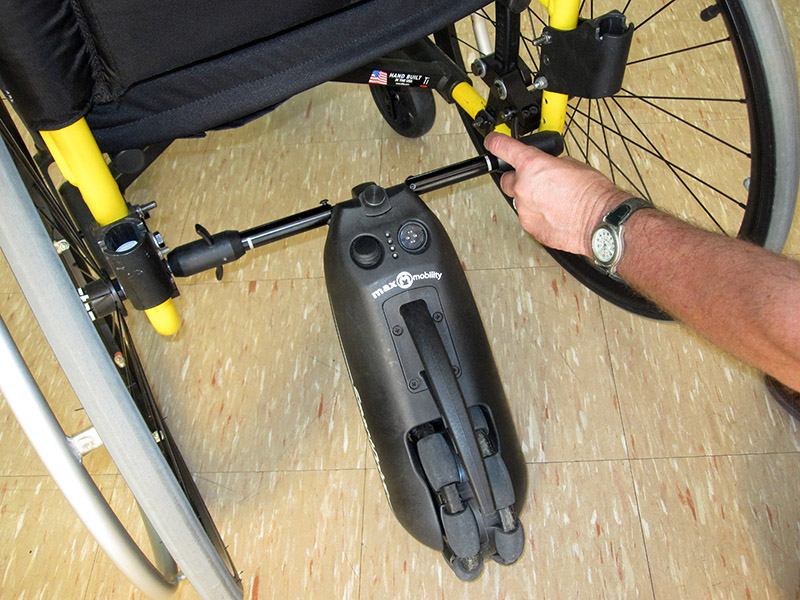
The folding-frame brackets cost about $300 as an upcharge, or more if purchased retrospectively.
-
Distance: Range of up to 20km (12 miles) per charge on fairly flat, easy terrain. Uphill uses more battery power. The wrist band should last about 10hrs per charge, and can be turned off when not in use to help it last longer.
-
Weight rating: 14-150kg (30-331lb) user weight. No comment is made in the manual about whether this includes the weight of the wheelchair.
-
Unit Weight: 5.7kg (12.5lb). The brackets and clamps weigh up to 400g.
-
Charging the Drive Unit: While in use, the drive unit will beep when the battery depletes to 20% charge, to prompt recharging as soon as possible and avoid completely running out. There are 4 blue LEDs on the drive unit that indicate the level of charge remaining. To charge the drive unit, it must be plugged into a mains power outlet via the SmartDrive charging cable for approximately 3hrs for a full charge. There are LEDs on the charge box that indicate power/charging/fully charged. When the drive unit is on, 4 blue lights means fully charged.
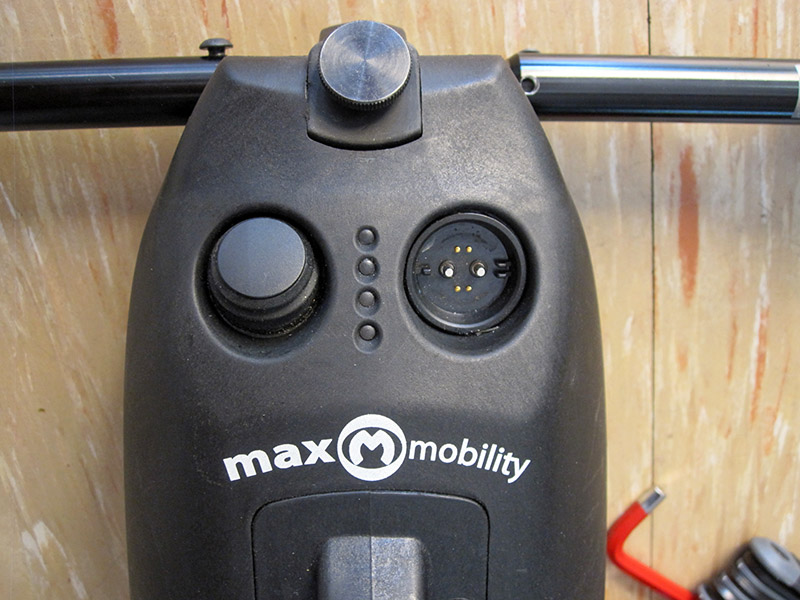
Power button, charging port and LED configuration
-
Charging the Wristband: When the wristband is in use, a low battery is indicated by the light flashing blue then red every 1.5sec. The wristband is charged by USB, so can be plugged into a computer, car charger, or mains power outlet. A full charge takes approximately 2.5hrs.
-
Wristband Details: The wristband is made from a flexible material, which feels like silicone or a similar polymer. The band is fairly easy to don. It involved opening the band, sliding hand through, squeezing with other hand to slide the two sides of the band across each other, then pushing the stopper through one of the slots.
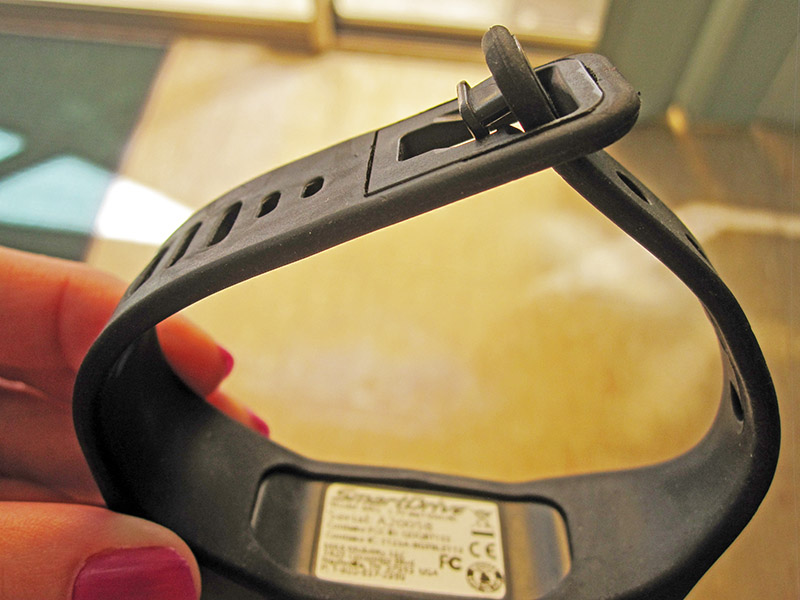
Wristband on maximum open setting
-
Travel: The SmartDrive can be taken on aeroplanes as carry-on luggage. Due to the lithium-ion battery, placing the drive unit in checked baggage may not be allowed. A certificate can be downloaded from the Max Mobility website to show your airline.
-
Warranty: 12 month manufacturers warranty.
-
Weather and Terrain: The SmartDrive is mainly intended for indoor and light outdoor use, e.g. shopping in town, getting around school/university/workplace, going for a walk down the street, etc. It isn't an "all terrain" option. The User Manual outlines conditions to avoid, such as icy surfaces, loose surface (sand, gravel etc.), or standing water (puddles or pools). The rep we spoke to advised that small puddles after light rain would probably be OK. This option wouldn't be suitable for hiking through the bush, using on the farm, or getting down to the beach. It might be OK on grass when used in combination with something like the Freewheel.
*Cost: In Australia, approximately $8,500.
How to Use the SmartDrive MX2:
The wristband is the main control while using the SmartDrive MX2. It replaces the indoor/outdoor button on the original SmartDrive, and makes the unit more responsive. The terminology has also changed from indoor/outdoor modes to training/everyday modes, though they are pretty much the same thing. The wristband has a coloured LED light that indicates the mode:
Green = training (indoor) mode, which is very sensitive.
Blue = everyday (outdoor) mode, which is less sensitive and faster.
Red = No go, drive unit off.
No light = wrist band off.
It also gives feedback using vibration, but may be inconsistent.
Once the user has the SmartDrive attached to their wheelchair, wristband on wrist, and is ready to go, turn the wristband on by pushing the button. Green mode should be activated. Green mode is recommended for training beginners, and it would probably be the most appropriate setting for manoeuvring around people and furniture.
When outdoors or needing more power, press and hold the button for 5 seconds, until the band vibrates and the light turns blue. Now, when the user pushes the wheels, the SmartDrive will maintain the top speed reached. The user should let the SmartDrive do all the propelling, but still keep their hands on the push rims for steering.
In indoor (green) mode, you can stop the SmartDrive by holding the wheels or rims, as per normal manual wheelchair use. This will not work in outdoor mode. To stop in outdoor (blue) mode, tap the wrist on the push rims. The SmartDrive will turn off, allowing the user to brake as they normally would, by holding the push rims. The wristband LED will be red.
When the user pushes the wheels again, the SmartDrive will re-engage and return to blue mode. This can cause issues in some situations, such as negotiating an obstacle. In this case, once stopped, press the button and hold until the wristband is off. Turn it on again once after passing the obstacle.
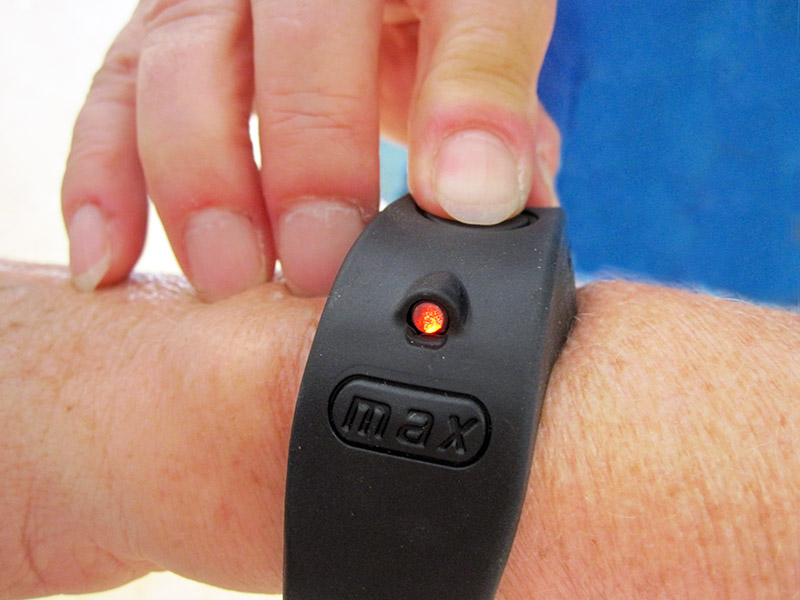
The button requires firm pressure
The SmartDrive MX2 may suit users who:
- Live an active lifestyle in a reasonably urban environment
- Have good wheelchair skills
- Have fast response times, reasonable cognition and sensible judgement.
For any user, good training is particularly important. The SmartDrive MX2 isn't a product that can be picked up and used fully from the start. As there is an extra step required to stop, practice is required before using the SmartDrive MX2 into the community. Conveniently, a training guide is provided in the back of the User Manual. This is a good start. Clients of therapists I have spoken with have had minor accidents using this equipment, even once they were familiar with it. For those who do learn to use it successfully, the SmartDrive can take the user's active lifestyle to the next level.
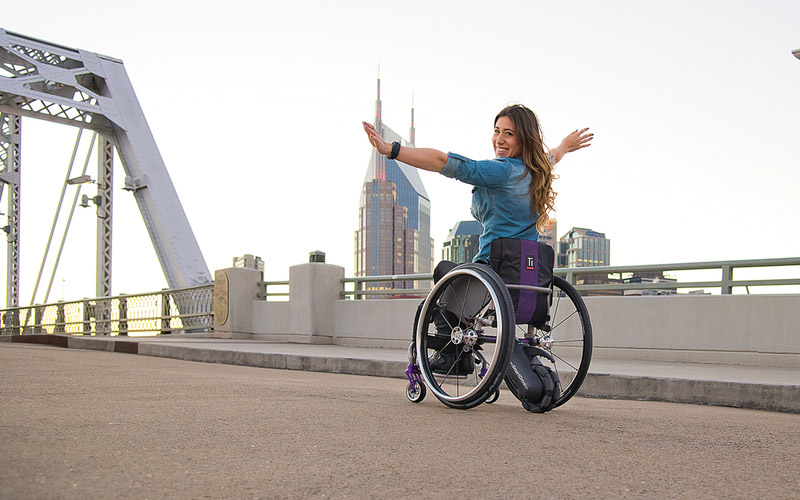
Image from Max Mobility website
I haven't prescribed a SmartDrive MX2 yet, but when I do, I will be sure to have at least 1-2hrs of client use before prescribing, at least 1 hour set aside for training once they've got it, and a week or two of using in very low-risk environments before taking it into the community. The extent of training required might be a drawback for some therapists (unless the supplier is willing and able to provide adequate training) and the safety aspects may make this product unsuitable for users with slow processing or response times.
Do you have any further thoughts or questions about the SmartDrive MX2? Please comment - for the benefit of the OT community!